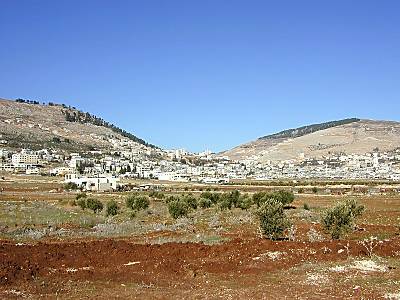But the nation of the Samaritans did not escape without tumults. The man who excited them to it was one who thought lying a thing of little consequence, and who contrived every thing so that the multitude might be pleased; so he bid them to get together upon Mount Gerizim, which is by them looked upon as the most holy of all mountains, and assured them, that when they were come thither, he would show them those sacred vessels which were laid under that place, because Moses put them there.This anonymous Samaritan may be called a Messiah in one sense (not on the original, as that is a Jewish concept), because he apparently announced the restoration of the cult in the Samarian temple, which was on Mount Gerizim - as implied by his claiming to be able to show Moses' sacred vessels. The Samaritan equivalent of the Jewish 'Messiah' is the Taheb ('Restorer'), which they interpret to be the prophet like unto Moses mentioned in Deuteronomy 18:15-18.
So they came thither armed, and thought the discourse of the man probable; and as they abode at a certain village, which was called Tirathana, they got the rest together to them, and desired to go up the mountain in a great multitude together; but Pilate prevented their going up, by seizing upon file roads with a great band of horsemen and foot-men, who fell upon those that were gotten together in the village; and when it came to an action, some of them they slew, and others of them they put to flight, and took a great many alive, the principal of which, and also the most potent of those that fled away, Pilate ordered to be slain.
But when this tumult was appeased, the Samaritan senate sent an embassy to Vitellius, a man that had been consul, and who was now president of Syria, and accused Pilate of the murder of those that were killed; for that they did not go to Tirathaba in order to revolt from the Romans, but to escape the violence of Pilate. So Vitellius sent Marcellus, a friend of his, to take care of the affairs of Judea, and ordered Pilate to go to Rome, to answer before the emperor to the accusations of the Jews.
So Pilate, when he had tarried ten years in Judea, made haste to Rome, and this in obedience to the orders of Vitellius, which he durst not contradict; but before he could get to Rome Tiberius was dead.
- Josephus, Antiquities 18.85-89
With this, Pontius Pilate disappears from the records of history once more. We will never know what happened to him after his dismissal. Pilate had remained in office for more than ten years (AD 26-36).
Appendix: the Physical Evidence of Pilate
The Pilate Stone (right) is a block of limestone with a carved inscription attributed to Pilate, found in 1961 by a team of Italian archeologists led by Dr. Antonio Frova in an ancient theater, built by decree of Herod the Great c. 30 BC, located in Caesarea Maritima (present-day Qesarya), the capital of Roman Judaea. On the partially damaged block is a dedication to Tiberius Caesar. As of now, this is the only known occurrence of the name Pontius Pilate in any ancient inscription. The stone is now located at the Israel Museum in Jerusalem, with a replica left on the site at Caesarea.
Since the text is so damaged - one can only make out the words Tiberieum, [Po]ntius Pilatus and [Praef]ectus Iuda[ea]e on it now - there are a number of proposals as to how the original text may have originally read. Here are some of them:
1.) [dis augusti]S TIBERIEVM [po]NTIVS PILATVS [praef]ECTVS IVDA[ea]E [fecit d]E[dicavit] "To the honorable gods (or To the Divine Augusti [i.e. Augustus and Livia]) the Tiberieum Pontius Pilatus, prefect of Iudaea, has made (and) dedicated."This inscription caused some sensation among experts, because it proves that Pilate's title was praefectus, and not procurator, as the Roman historian Tacitus states in his Annals.
2.) [caesarien(ibu)]S TIBERIEVM [po]NTIVS PILATVS [praef]ECTVS IVDA[ea]E [d]E[dit] "The Caesareans' (i.e. people of Caesarea Maritima) Tiberieum, Pontius Pilatus, prefect of Iudaea, dedicates."
3.) [kal(endis) iulii]S TIBERIEVM [m (arcus) ? pon]NTIVS PILATVS [praef]ECTVS IVDA[ea]E [d]E[dicavit] " "The Tiberieum of the kalends of July Marcus (?) Pontius Pilatus, prefect of Iudaea, has dedicated."
4.) [opu]S TIBERIEVM... "The Tiberieum building..."
5.) [iudaei]S TIBERIEVM... "The Judeans' (Jews') Tiberieum..."
6.) [nemu]S TIBERIEVM... "The Tiberieum of the (sacred) grove..."
7.) [munu]S TIBERIEVM... "The municipal Tiberieum..."
8.) [nauti]S TIBERIEVM [pon]NTIVS PILATVS [praef]ECTVS IVDA[ea]E [r]E[fecit] "The seamen's Tiberieum Pontius Pilatus, Prefect of Iudaea, restores."
The title used by the governors of the region varied depending on the period. When Samaria, Judaea proper and Idumea were first amalgamated into Judaea Province, from AD 6 to the outbreak of the First Jewish Revolt in AD 66, officials of the equestrian order governed. They held the Roman title of praefectus until Herod Agrippa I was named 'King of the Judaeans' by the emperor Claudius. After Herod Agrippa's death in AD 44, when Judaea reverted to direct Roman rule, the governor began to held the title procurator. When applied to governors, the title procurator, otherwise used for financial officers, connotes no difference in rank or function from the title known as prefect. Contemporary archaeological finds and documents such as the Pilate Stone attest to the governor's more accurate official title only for the years 6 through 44: prefect.




No comments:
Post a Comment